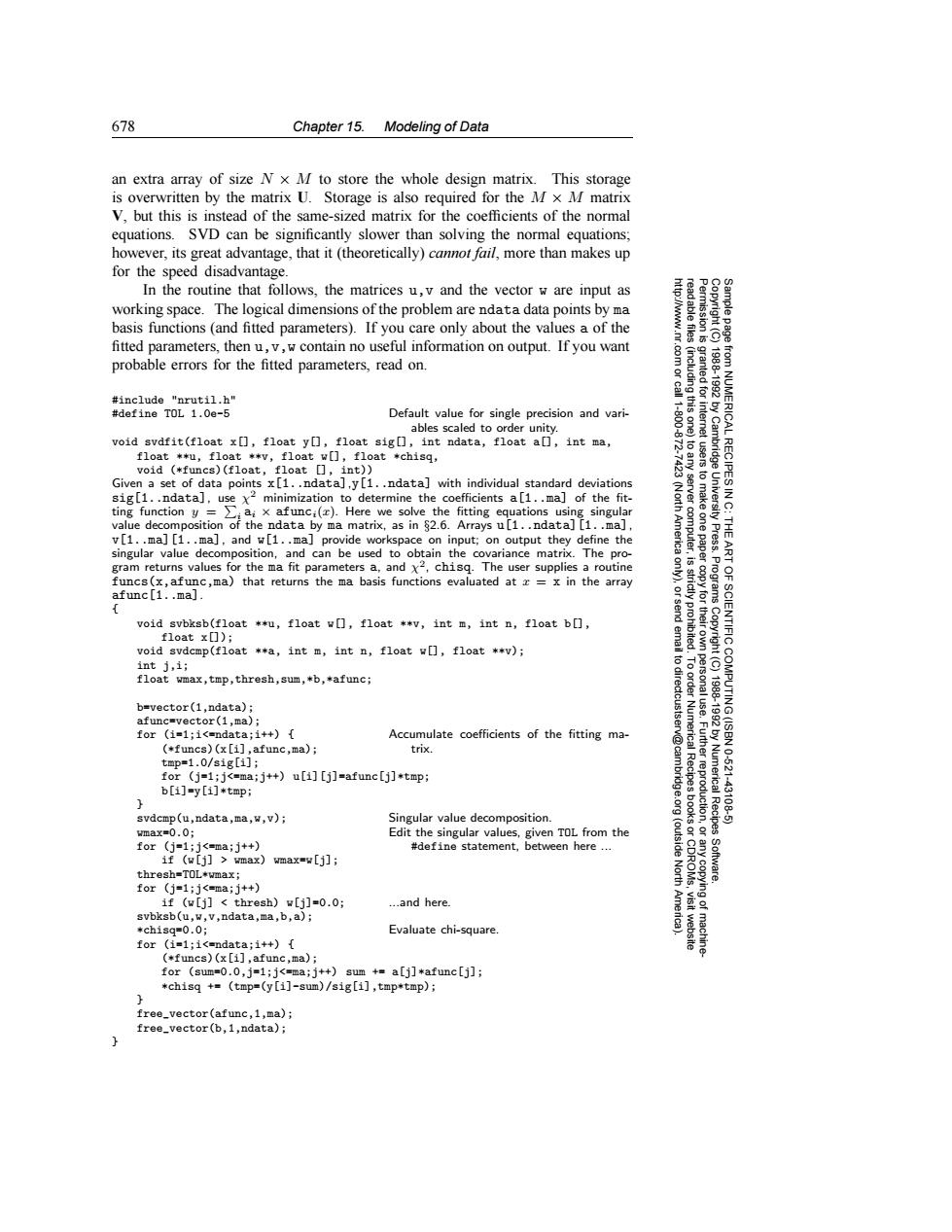正在加载图片...

678 Chapter 15.Modeling of Data an extra array of size N x M to store the whole design matrix.This storage is overwritten by the matrix U.Storage is also required for the M x M matrix V,but this is instead of the same-sized matrix for the coefficients of the normal equations.SVD can be significantly slower than solving the normal equations; however,its great advantage,that it(theoretically)cannot fail,more than makes up for the speed disadvantage. In the routine that follows,the matrices u,v and the vector w are input as working space.The logical dimensions of the problem are ndata data points by ma basis functions (and fitted parameters).If you care only about the values a of the fitted parameters,then u,v,w contain no useful information on output.If you want probable errors for the fitted parameters,read on. 19881992 #include "nrutil.h" #define TOL 1.0e-5 Default value for single precision and vari- ables scaled to order unity void svdfit(f1oatx[],float y[l,float sig[☐,int ndata,f1oata☐,int ma, float **u,float **v,float w[],float *chisg, from NUMERICAL RECIPESI void (*funcs)(float,float []int)) Given a set of data points x[1..ndata],y[1..ndata]with individual standard deviations sig[1..ndata],use x2 minimization to determine the coefficients a[1..ma]of the fit- (Nort server 令 ting function y =>ai x afunci(x).Here we solve the fitting equations using singular value decomposition of the ndata by ma matrix,as in $2.6.Arrays u[1..ndata][1..ma], THE v[1..ma][1..ma],and w[1..ma]provide workspace on input;on output they define the Americ computer, singular value decomposition,and can be used to obtain the covariance matrix.The pro- ART gram returns values for the ma fit parameters a,and x2,chisq.The user supplies a routine funcs(x,afunc,ma)that returns the ma basis functions evaluated at x =x in the array afunc[1..ma] Programs void svbksb(float**u,float w[,f1oat**v,intm,intn,float b☐ f1oatx▣); void svdcmp(float **a,int m,int n,float w,float **v); int j,i; to dir float wmax,tmp,thresh,sum,*b,*afunc; b=vector(1,ndata); OF SCIENTIFIC COMPUTING(ISBN afunc=vector(1,ma); 19881992 for (i=1;i<-ndata;i++){ Accumulate coefficients of the fitting ma- (*funcs)(x[i],afunc,ma); trix. tmp=1.0/sig[1]; 10-621 for (j=1;j<=ma;j++)u[i][j]=afunc[j]*tmp; b[i]=y[i]*tmp; 43108 svdcmp(u,ndata,ma,w,v); Singular value decomposition. Numerical Recipes wmax=0.0; Edit the singular values,given TOL from the for (j=1;j<=ma;j++) #define statement,between here... (outside if (w[j]wmax) wmax=w[】; thresh=TOL*wmax; North Software. for (j=1;j<=ma;j++) if (w[j]thresh)w[j]=0.0; ...and here. svbksb(u,w,v,ndata,ma,b,a); *chisq=0.0; Evaluate chi-square. for (i=1;i<=ndata;i++){ (*funcs)(x[i],afunc,ma); for (sum=0.0,j=1;j<=ma;j++)sum +a[j]*afunc[j]; *chisq +(tmp=(y[i]-sum)/sig[i],tmp*tmp); free_vector(afunc,1,ma); free_vector(b,1,ndata);678 Chapter 15. Modeling of Data Permission is granted for internet users to make one paper copy for their own personal use. Further reproduction, or any copyin Copyright (C) 1988-1992 by Cambridge University Press. Programs Copyright (C) 1988-1992 by Numerical Recipes Software. Sample page from NUMERICAL RECIPES IN C: THE ART OF SCIENTIFIC COMPUTING (ISBN 0-521-43108-5) g of machinereadable files (including this one) to any server computer, is strictly prohibited. To order Numerical Recipes books or CDROMs, visit website http://www.nr.com or call 1-800-872-7423 (North America only), or send email to directcustserv@cambridge.org (outside North America). an extra array of size N × M to store the whole design matrix. This storage is overwritten by the matrix U. Storage is also required for the M × M matrix V, but this is instead of the same-sized matrix for the coefficients of the normal equations. SVD can be significantly slower than solving the normal equations; however, its great advantage, that it (theoretically) cannot fail, more than makes up for the speed disadvantage. In the routine that follows, the matrices u,v and the vector w are input as working space. The logical dimensions of the problem are ndata data points by ma basis functions (and fitted parameters). If you care only about the values a of the fitted parameters, then u,v,w contain no useful information on output. If you want probable errors for the fitted parameters, read on. #include "nrutil.h" #define TOL 1.0e-5 Default value for single precision and variables scaled to order unity. void svdfit(float x[], float y[], float sig[], int ndata, float a[], int ma, float **u, float **v, float w[], float *chisq, void (*funcs)(float, float [], int)) Given a set of data points x[1..ndata],y[1..ndata] with individual standard deviations sig[1..ndata], use χ2 minimization to determine the coefficients a[1..ma] of the fitting function y = i ai × afunci(x). Here we solve the fitting equations using singular value decomposition of the ndata by ma matrix, as in §2.6. Arrays u[1..ndata][1..ma], v[1..ma][1..ma], and w[1..ma] provide workspace on input; on output they define the singular value decomposition, and can be used to obtain the covariance matrix. The program returns values for the ma fit parameters a, and χ2, chisq. The user supplies a routine funcs(x,afunc,ma) that returns the ma basis functions evaluated at x = x in the array afunc[1..ma]. { void svbksb(float **u, float w[], float **v, int m, int n, float b[], float x[]); void svdcmp(float **a, int m, int n, float w[], float **v); int j,i; float wmax,tmp,thresh,sum,*b,*afunc; b=vector(1,ndata); afunc=vector(1,ma); for (i=1;i<=ndata;i++) { Accumulate coefficients of the fitting ma- (*funcs)(x[i],afunc,ma); trix. tmp=1.0/sig[i]; for (j=1;j<=ma;j++) u[i][j]=afunc[j]*tmp; b[i]=y[i]*tmp; } svdcmp(u,ndata,ma,w,v); Singular value decomposition. wmax=0.0; Edit the singular values, given TOL from the for (j=1;j<=ma;j++) #define statement, between here ... if (w[j] > wmax) wmax=w[j]; thresh=TOL*wmax; for (j=1;j<=ma;j++) if (w[j] < thresh) w[j]=0.0; ...and here. svbksb(u,w,v,ndata,ma,b,a); *chisq=0.0; Evaluate chi-square. for (i=1;i<=ndata;i++) { (*funcs)(x[i],afunc,ma); for (sum=0.0,j=1;j<=ma;j++) sum += a[j]*afunc[j]; *chisq += (tmp=(y[i]-sum)/sig[i],tmp*tmp); } free_vector(afunc,1,ma); free_vector(b,1,ndata); }�